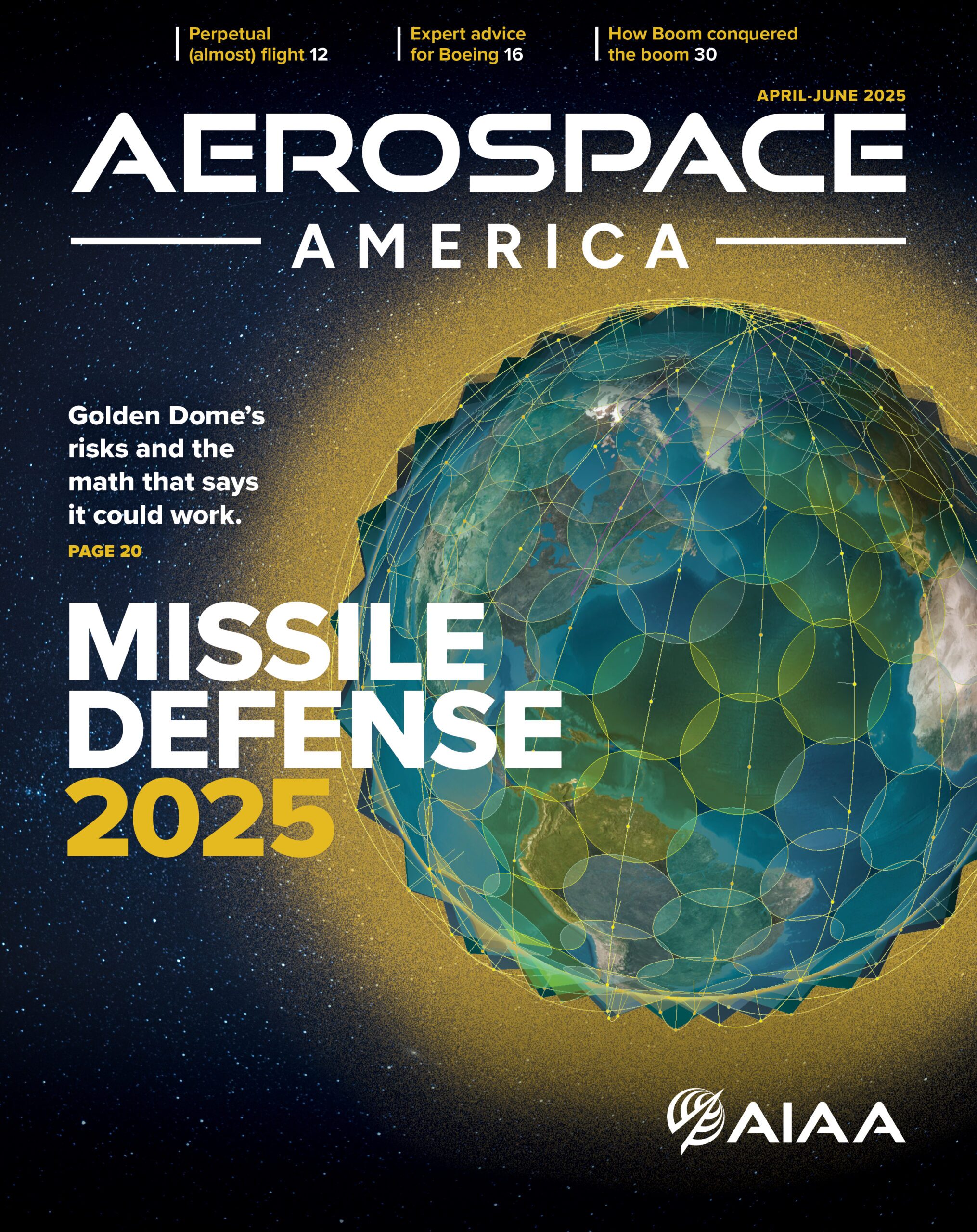Stay Up to Date
Submit your email address to receive the latest industry and Aerospace America news.
1925
Oct. 3 — The aircraft carrier USS Lexington is launched at Quincy, Massachusetts. This converted battlecruiser enters service in late 1927 and operates until 1942, when it is sunk at the Battle of the Coral Sea. Aircraft Year Book, 1925, p. 120.
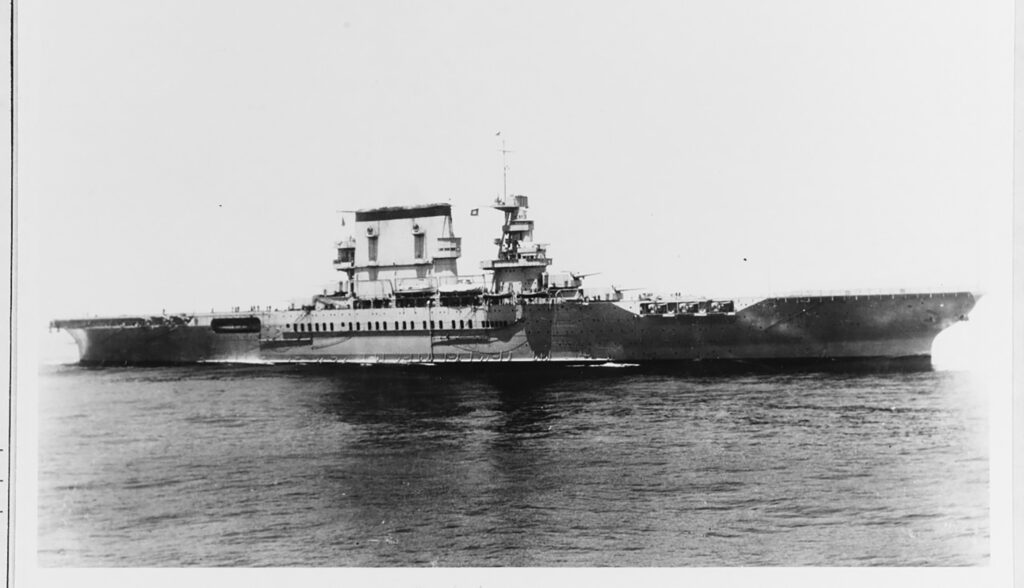
Oct. 7 — The U.S. Post Office Department awards air mail contracts to civilian companies, which marks the beginning of the commercial airline industry in the United States. NASA, Aeronautics and Astronautics, 1915-1960, p. 20
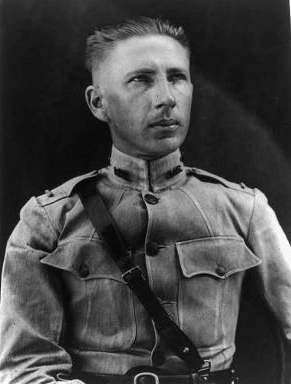
Oct. 12 — U.S. Army Lt. Cyrus Bettis wins the Pulitzer Trophy and sets two new world speed records during flights in his Curtiss R3C-1 racer at Mitchel Field, Long Island. Bettis averages 249.3 mph (401.2 kph) over 100 kilometers, and 248.9 mph (400.5 kph) over 200 km on closed courses. Flight, Oct. 15, 1925, p. 679.
Oct. 15 — Sqn. Ldr. Rollo Haig of the Royal Air Force completes tests over Pulham, England, that consist of dropping and rehooking a de Havilland DH. 53 from the R.33 rigid airship. The DH. 53 has a slight mishap when it attempts to rehook to the trapeze gear, but both airship and airplane return to Earth safely. Successful experiments on a similar line were done Sept.18 at Langley Field, Virginia, when a Sperry Messenger biplane hooked on and off the U.S. Army’s D-3 airship. The Aeroplane, Oct. 21, 1925.
Oct. 23 — U.S. Army Air Service Lt. James H. “Jimmy” Doolittle becomes the second U.S. airman to win the Schneider Trophy Race for high-performance seaplanes. During the race at Baltimore, Maryland, Doolittle averages 232.573 mph (374.289 kph) in a Curtiss R3C-2 racer. On Oct. 27, Doolittle sets a new seaplane record in the R3C-2, flying over a 3-kilometer course eight times. His 245.713-mph average (395.437 kph) for the four best flights, two in either direction, beats the record set in September by Supermarine. The R3C-2 racer later passes into the collection of the Smithsonian’s National Air and Space Museum. The Aeroplane. Nov. 4, 1925, p. 530.
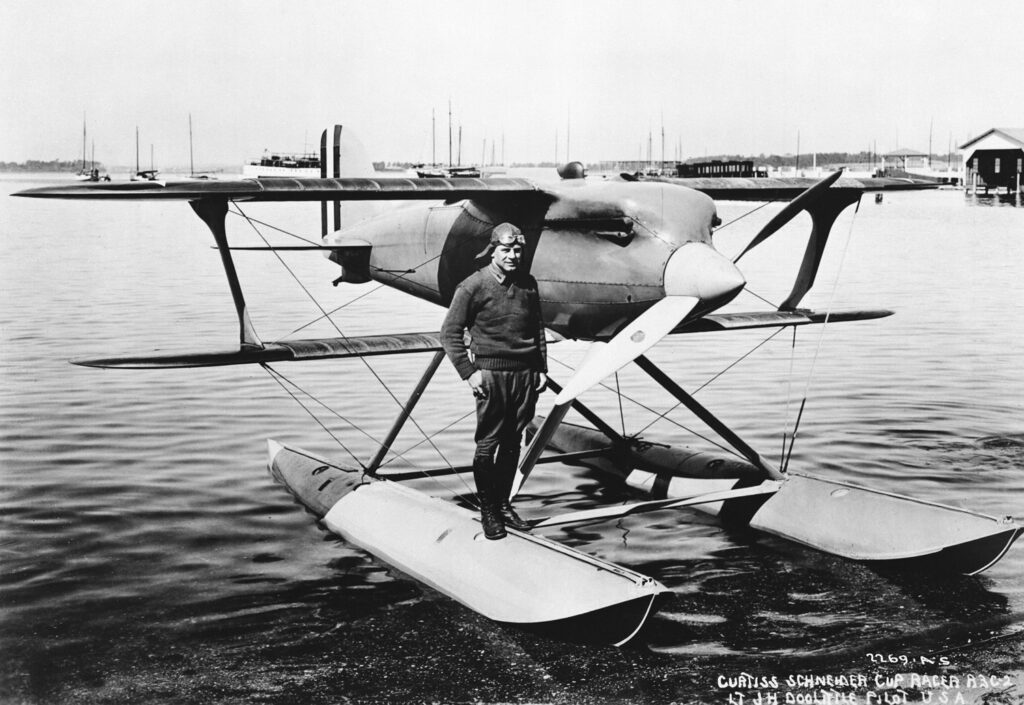
1950
Oct. 6 — BOAC, one of British Airways’ predecessors, retires the last of its Avro York transports from active passenger service. They are replaced with Lockheed Constellations, which cut the flying time by seven hours. BOAC keeps 10 Yorks as freighters. Aviation Week, Oct. 9, 1950, p. 11; Kenneth Munson, Airliners Since 1946, p. 128.
Oct. 10 — The Boulton Paul P.111 research airplane completes its first test flight at the Aeroplane and Armament Experimental Establishment in Boscombe Down, Wiltshire. A single Rolls-Royce Nene turbojet powers this delta wing design, and its leading edge has detachable tips for comparing the effectiveness of blunt and pointed tips. In 1953, the P.111 is modified and redesignated the P.111A. The Aeroplane, Nov. 10, 1950, p. 400; William Green and Roy Cross, The Jet Aircraft of the World, p. 118.
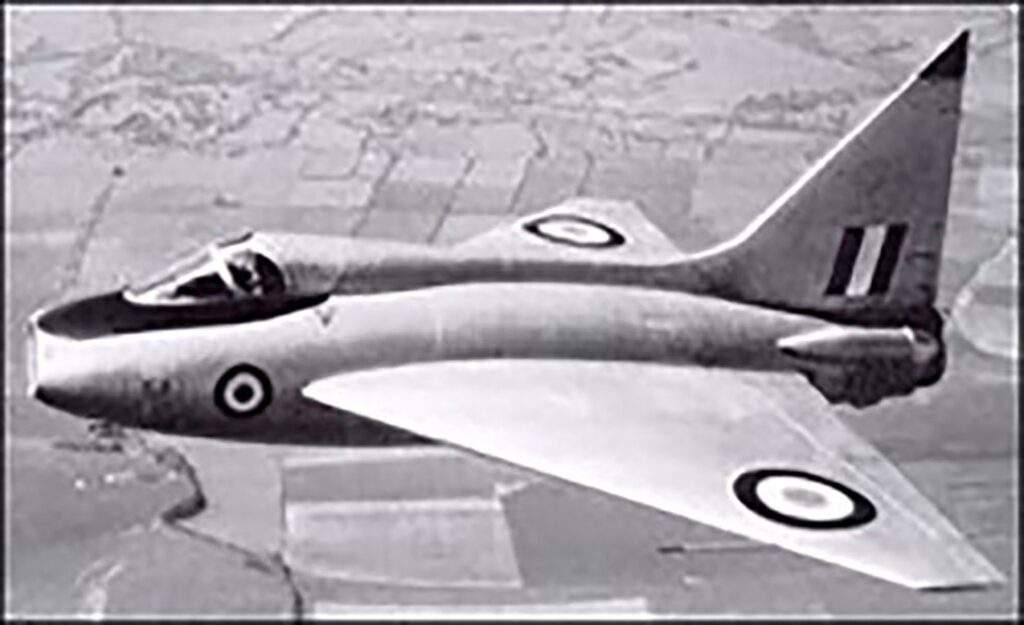
Oct. 21 — Martin test pilots complete the inaugural flight of the Martin 4-0-4 prototype. This 40-passenger airliner was designed to address the handling difficulties of the earlier Martin 2-0-2. Martin produces 103 of the 4-0-4s for Trans World Airlines and Eastern. The U.S. Coast Guard takes two more as RM-1 transports. By 1971, 40 of the aircraft remain in service, mostly with Piedmont Airlines and Southern Airways. Aviation Week, Oct. 30, 1950, p. 13; Munson, Airliners Since 1946, pp. 102-103.
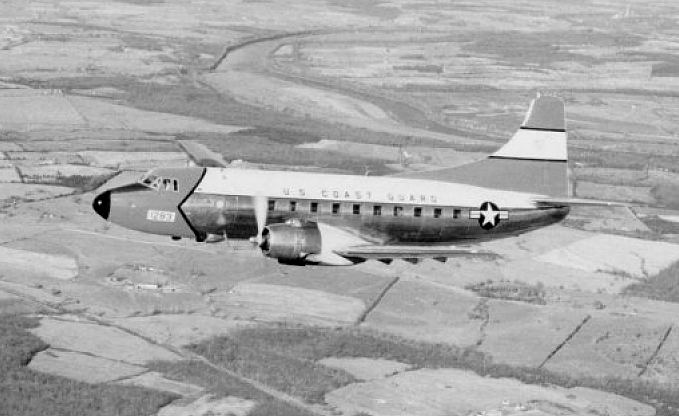
Also during October — The Wright Aeronautical Corp., a division of Curtiss-Wright, announces its purchase of the American rights to manufacture the Armstrong Siddeley Sapphire axial-flow turbojet engine. Curtiss-Wright hopes to install the engines in U.S. aircraft currently using the Allison J35 and the General Electric J47, which include the Republic F-84, Boeing B-47, North American B-45 and F-86, Convair B-36 and Northrop F-89. The Sapphire goes into production as the J65-W-1 and later powers the Republic F-84 Thunderstreak and Thunderflash series. Aviation Week, Oct.16, 1950, pp. 12-13.
Also during October — The U.S. Air Force selects the YC-122C and XC-123 transport designs by Chase Aircraft Co. for its next assault transport. Fairchild Aircraft receives the production contract and builds a limited production of the YC-122C before moving onto quantity production of the C-123B. This design, a powered development of the XCG-20 glider with two Pratt & Whitney R-2800 piston radial engines, can carry 61 troops plus two pilots at a maximum speed of 245 mph (395 kph). The first production C-123Bs are delivered to the 309th Troop Carrier Group of Troop Carrier Command in 1955. The C-123 sees world-wide service with the Air Force’s Tactical Air Command, including operations in Southeast Asia. Aviation Week, Oct. 23, 1950, pp. 11-12; F. G. Swanborough, United States Military Aircraft Since 1909, pp. 266-267.
1975
Oct. 5 — NASA announces that the University of Chile will build and operate a ground station to receive earth-resources direct from NASA’s Landsat 1 and 2 satellites. The site is the 10th Landsat ground station and will aid South American investigators who conduct earth resource research with NASA and the United Nations. NASA Release 75-265.
Oct. 10 — NASA’s Marshall Space Flight Center hosts the first of a series conferences on the design requirements for payloads aboard the space shuttles and Spacelab station. About 50 scientists and engineers from government, industry and universities meet to discuss this Space Processing Applications (SPA) program, including conducting analyses of selected design applications. MSFC News Release 75-218.
Oct. 12 — The Soviet and American participants in July’s Apollo-Soyuz Test Project visit President Gerald Ford in the White House, kicking off a two-week tour that includes stops in Chicago, Omaha, Salt Lake City, San Francisco, Reno, Lake Tahoe, Los Angeles, Atlanta, Nashville and New York City. Cosmonauts Valery Kubasov and Gen. Aleksey Leonov are accompanied by their wives and children, as well as Gen. Vladimir Shatalov, the director of cosmonaut training, plus support staff and Soviet journalists. Astronauts Thomas Stafford, Vance Brand and Deke Slayton are accompanied by their wives. Other NASA personnel in attendance include Administrator James Fletcher. NASA News Release 75-276.
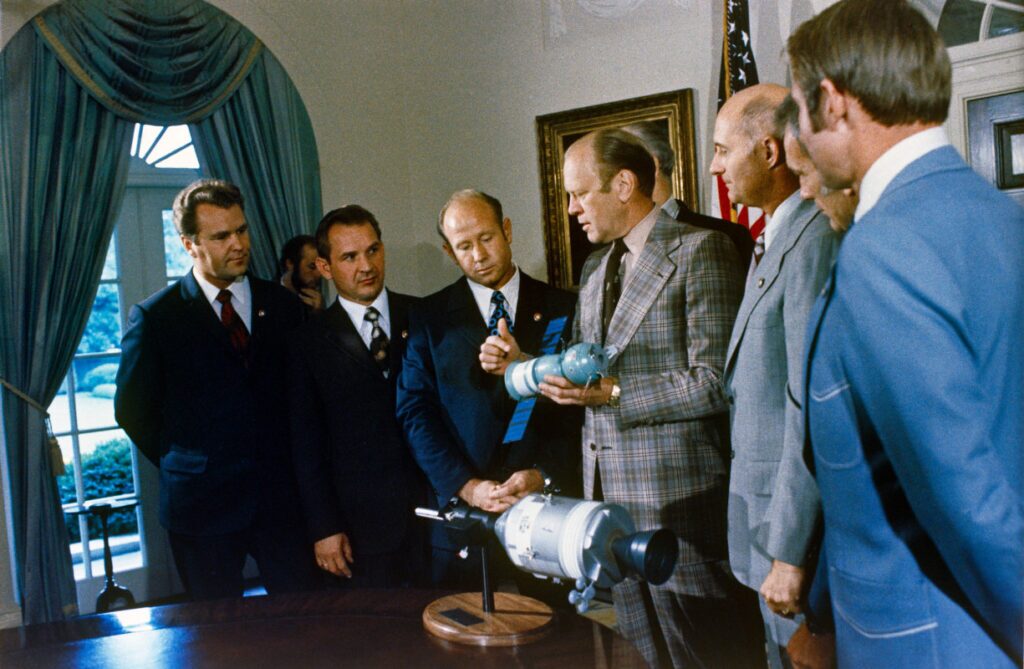
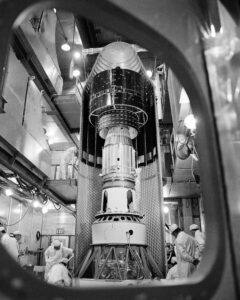
Oct. 16 — NOAA’s first Geostationary Operational Environmental Satellite is launched aboard a Delta rocket from NASA’s Kennedy Space Center in Florida. Designated GOES 1 once on orbit, the satellite provides NOAA scientists with images of a quarter of Earth’s surface at 30-minute intervals, day and night. GOES also collects and relays non-visual environmental data transmitted from thousands of remote-sensing facilities on land and sea. NOAA Release 75-188.
Oct. 20-22 — More than 100 astronomers from the U.S. and other countries gather for a symposium at NASA’s Goddard Space Flight Center to exchange information on X-ray astronomy. Discussions largely focus on compact double star systems that emit X-rays and have been observed by spacecraft. Astronomers consider the compact stars in these binary systems the most exciting objects of current astronomical research because, for example, they have masses close to Earth’s sun but diameters of only 10 km. NASA News Release 75-279.
Oct. 22-25 — The Soviet Union becomes the first country to land a spacecraft on Venus, where temperatures reach 500 degrees Celsius and pressures are up to 100 times that of Earth’s atmosphere. Upon arriving in orbit, the Venera 9 and 10 probes release their landers. After slow descent through the dense atmosphere, each craft functions for roughly an hour, capturing the first pictures of the planet’s surface. New York Times, Oct. 23, 1975, p. 1, and Oct. 26, 1975, p. A3.
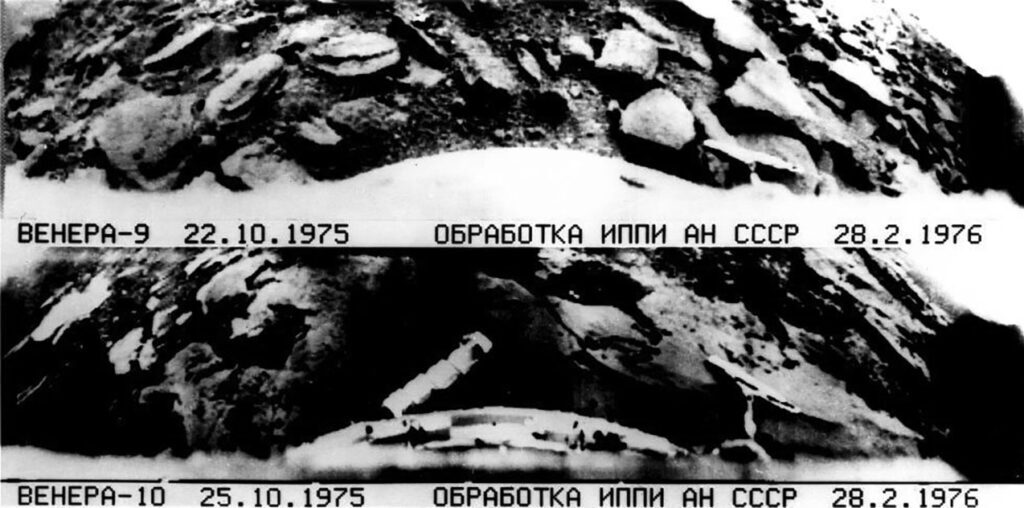
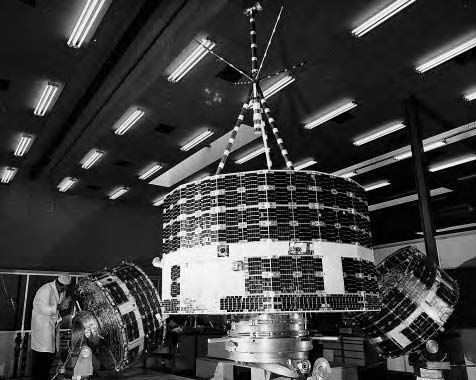
Oct. 28 — HEOS-1, Europe’s longest operational satellite, reenters the atmosphere as predicted after exceeding its nominal lifetime by nearly six years. Launched in 1968, HEOS-1 was the third of eight scientific satellites launched by the European Space Agency and European Space Research Organization between 1968 and 1975. Its full payload of seven experiments yielded results longer than its nominal lifetime in studying the interplanetary magnetic field, high energy galactic cosmic rays, and solar protons and providing data for almost seven of the 11 years of a solar cycle. ESA News Release, Oct. 29,1975.
Oct. 30 — The U.S. Air Force completes test flights with an F-11D turbofan jet turbine, featuring all-composite third-stage fan blades that are 40% lighter than the conventional titanium fan blades. The tests, conducted at Edwards Air Force Base in California, mark the first military flight evaluation of a rotating structural engine component made of composite materials. Air Force System Command News Review, October 1975, p. 1.
2000
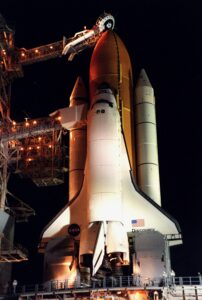
Oct. 11 — The space shuttle Discovery launches from NASA’s Kennedy Space Center in Florida on the 100th shuttle flight, carrying the Z1 truss and a new docking port for the International Space Station. The STS-97 crew will dock at that port in December to install the truss and the first pair of solar arrays on the U.S. Unity module. Flight International, Oct. 24-30, 2000, p. 32.
Oct. 17-23 — The IRIS-T short-range air-to-air missile completes its first test flight. IRIS-T program involves Germany, Canada, Italy, Norway, Sweden and Greece and delivers the first operational missiles in 2005 to the German Air Force. Flight International, Nov. 7-13, 2000. p. 17.
Oct. 24 — Lockheed Martin completes the inaugural flight of the X-35A, a concept demonstrator for the future F-35 Joint Strike Fighter. After taking off from the 600-meter (2,000-foot) runway in Palmdale, California, the demonstrator climbs to an altitude of 10,000 feet without the use of an afterburner. Flight International, Oct. 31-Nov. 6, 2000, p. 6.
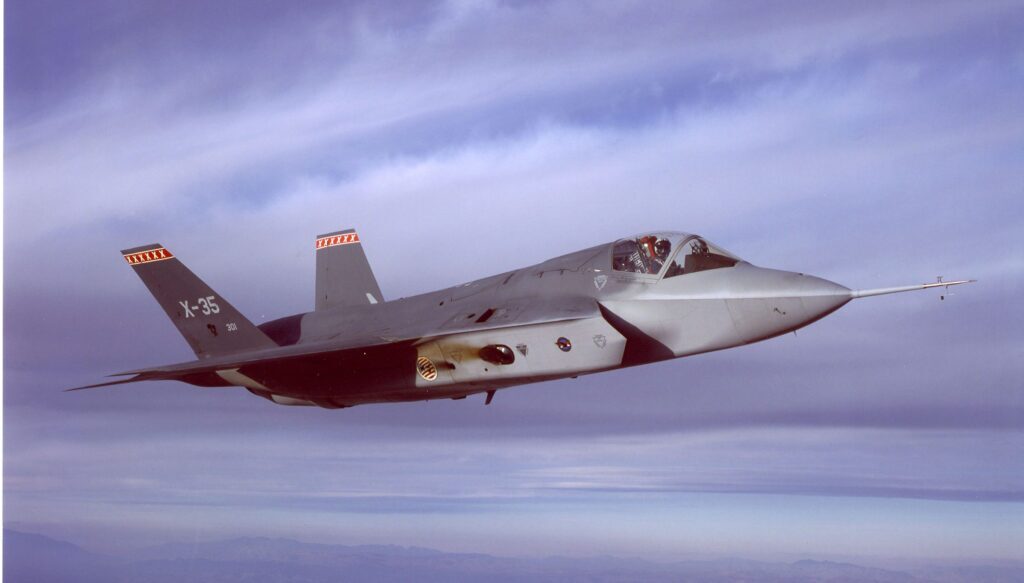
Oct. 31 — Sea Launch LLC launches a Russian Zenit 3SL rocket carrying the Thuraya communications satellite for the United Arab Emirates. At 11,260 pounds (5,108 kg) this is the heaviest commercial payload to date. Flight International, Oct. 31 – Nov. 6, 2000, p. 32.
Oct. 31 — China’s first navigation satellite, BNTS-1, launches aboard a Long March 3A. This is the first satellite in China’s planned Beidou Navigation System for highway, rail and sea-going traffic, as well as for military operations. Flight International, Nov. 7-13, 2000, p. 32.
About Frank Winter
Frank H. Winter is the retired curator of rocketry at the Smithsonian’s National Air and Space Museum in Washington, D.C. The author of multiple books, he’s co-authored Aerospace America’ Looking Back column since 1972.
About robert van der linden
Robert van der Linden is a curator in the National Air and Space Museum’s aeronautics department specializing in the history of air transportation. He’s written multiple books, including "Airlines and Air Mail: The Post Office and the Birth of the Commercial Aviation Industry."
Stay Up to Date
Submit your email address to receive the latest industry and Aerospace America news.
